Sign of the times
(by peter)
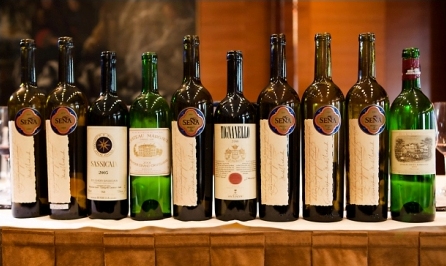 What do you get when you put six Chilean ‘icon’ wines, two Bordeaux first growths, two Super Tuscans and fifty-odd tasters in a plush hotel room in London – and ask for a judgement call?
What do you get when you put six Chilean ‘icon’ wines, two Bordeaux first growths, two Super Tuscans and fifty-odd tasters in a plush hotel room in London – and ask for a judgement call?
The punch-line, while surprising, is no joking matter.
Eduardo Chadwick’s Seña wine emerged triumphant in this latest version of what has become a one-man roadshow extolling the virtues of fine Chilean reds by pitting them against some of the most celebrated and expensive names in wine in a series of blind tastings.
This latest tasting – the ‘Seña Vertical’ – took place at the Four Seasons in London on 18th May 2012. I was invited to help chair the event alongside owner Eduardo Chadwick and Steven Spurrier, organiser of the original ‘Judgement of Paris’ tasting in 1976.
I’d also co-chaired the previous Errázuriz ‘Berlin’ tasting in London in May 2009, in which Eduardo Chadwick put the latest releases of his top wines – Seña, Viñedo Chadwick and Don Maximiano – against top wines including Opus One, Sassicaia, Solaia, Château Margaux, Château Latour and Château Lafite. On that occasion, the results went more in favour of the Old World than the New (Margaux, Lafite and Solaia emerging top).
This time, however, the idea was to look at the theme of ageability and maturity in wines going back over several years, focusing on just one Chilean wine – Seña – against other examples from Europe. There were around 50 tasters at the event, including some top UK trade members (as well as a strong Chinese contingent.)
The results speak for themselves. Below is the official overall group result, in descending order of preference:
1st – Seña 2008
2nd – Seña 2010
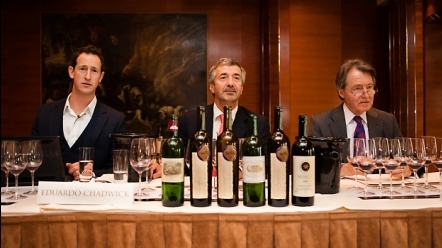 3rd equal – Château Margaux 2001
3rd equal – Château Margaux 2001
3rd equal – Sassicaia 2005
5th – Seña 2001
6th – Tignanello 2008
7th – Seña 2005
8th – Seña 1997
9th – Seña 1995
10th – Château Lafite 1995
For ease of comparison, and for what it’s worth, my personal rating was as follows (you can read my notes, as well as some general comments, in the ‘Tasting notes’ section at the end of this piece):
1st – Seña 1997
2nd – Tignanello 2008
4th – Seña 2005
5th – Château Lafite 1995
6th – Seña 2010
7th – Seña 1995
8th – Seña 2001
9th – Seña 2008
10th – Sassicaia 2005
It’s worth noting the disparities, particularly the fact that the group’s favourite, Seña 2008, was my second to last rating, and the Sassicaia 2005 – 3rd equal in the overall group result – was my lowest result. I also rated the Seña 1997 as my top wine, whereas the group had it in 8th position overall; similarly, I clearly ranked the Lafite 1995 higher than many others in the room.
It’s also important to point out, for fairness, that there were six Seña wines on show, versus only four from elsewhere, so this somewhat stacked the deck in Chile’s favour from the off.
Before the tasting, Eduardo Chadwick had said: ‘The reason I started running these tastings was that I suspected our top wines were being downgraded in scores simply because they were from Chile. That’s why I wanted ‘blind justice’. My aim with these tastings isn’t to prove our wines are better than others. Just to prove they’re world class.’
After it, he spoke as follows: ‘I’m delighted with the results. One of the key criticisms of Chilean wines is that they don’t age well. Today, we’re proving they can and do. The wines speak for themselves – as does the consistency of results from around the world, which show a real appreciation for Chilean wines.’
I took three key conclusions away from the event.
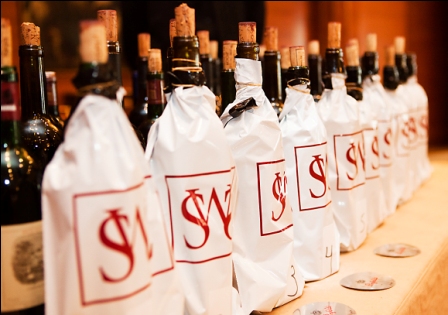 Firstly, that fine Chilean wine is undoubtedly world class and can challenge the best in quality terms when evaluated without prejudice.
Firstly, that fine Chilean wine is undoubtedly world class and can challenge the best in quality terms when evaluated without prejudice.
Secondly, that Seña is an excellent wine, of great pedigree, and one with a very bright future ahead of it. The project has come a long way since it was first set up in 1996 as a trail-blazing joint venture between Californian wine pioneer Robert Mondavi and Eduardo Chadwick of Errázuriz. But even those early vintages have aged remarkably well, and the latest wines are extremely impressive.
Finally, that – as far as I am concerned – high alcohol remains perhaps the single most significant impediment in Chile’s quest for ultimate pedigree in its fine wines. I am aware this is a contentious issue, and many tasters on the day disagreed with me – I marked down Seña 2008 and 2010 for their invasive heat, but many considered them to be balanced. But I find the combination of ripe fruit, low(ish) acidity and fierce alcohol (ie 14.5% and up) very much inhibits my enjoyment of a wine, and means I can only drink limited quantities and with very specific dishes. Drinkability, versatility with food and refreshment value are much under-valued qualities in wine – but for me they are paramount, and excess alcohol almost always acts detrimentally to these attributes.
We did discuss this issue briefly at the tasting and I think it’s only fair to report what Eduardo Chadwick said. ‘For me, 13.5-14.5% is where we reach the best expressions of our wines. The key is balance, and I feel even the wines with the higher alcohols have it. In the UK there is a great sensibility to alcohol – despite the fact you drink Port and the latest vintages of Bordeaux are notably high in alcohol too! I’m not pro-alcohol – I’m pro-balance and finesse. For me, we get this balance at the higher alcohol.’
By way of background, Seña sells for around £50-75 retail. Around 80,000 bottles are made per year. Initially the wine was made from a barrel selection of old vineyards from the Errázuriz estate in the Aconcagua Valley, as well as bits from a grower in the cooler, windier mid-part of the Aconcagua Valley near Ocoa.
In 1999 a new estate near Ocoa, exclusively dedicated for Seña production, was purchased and planted. Nowadays the wine is made from typically 90% fruit from the Seña estate, but blending components from other top Errázuriz vineyards within Aconcagua are still used. The varieties planted include Cabernet Sauvignon – always the backbone of this wine – Merlot, Carmenere, Cabernet Franc, Malbec, Syrah and Petit Verdot.
Following the disbanding of the joint venture in 2005, when Mondavi was taken over by Constellation, further plantings were put in and the Seña vineyard was converted to biodynamic management.
You can find the official press release from the event here: First Seña Vertical Tasting in London – May 18th
TASTING NOTES
- The below are my individual tasting notes and scores.
- I’ve included thoughts on origin for illustrative purposes, even though these were not central to my marking – I was focused on evaluating purely and simply quality in the glass, with origin a minor consideration.
- All wines were served blind in the order listed below.
- Tasters then rated their wines in order of preference from 1 to 10.
- All marks were submitted and collated before the discussion, when the merits (or otherwise) of each wine was debated before the wine was revealed.
- The marks of the chairing panel (me, Eduardo Chadwick and Steven Spurrier) were not taken into account. I had no prior information on the wines being served.
- I include some selected comments from others made during the discussion of the wines below each note.
1 – Château Lafite Rothschild 1995, Pauillac, 13% – Mature in hue, but more youthful than the 2nd wine: still some ruby at the core but also brackish hints at the rim. A lovely perfume: exotic aromas of dried dark fruits, tobacco and undergrowth. Lovely complexity and evolution. Bay leaf and warm earth. A grassy edge to it. On the palate, it has a sturdy attack; very fine tannin, dense and plentiful. Burly. It’s got plenty of warming spice but maybe lacking a little bit of linearity and follow-through on the finish. That said, it’s very savoury and elegantly evolved. Beautiful drinking wine. But perhaps just not first class on the finish. I’d say very fine claret from not a great vintage. 8-7.5/10
(Greg Sherwood MW commented on this wine: ‘The acidity holds it together beautifully even if it’s a bit faded; classicists will gulp this down. Perhaps the 1995 vintage was a bit over-egged – it wasn’t that exciting.’)
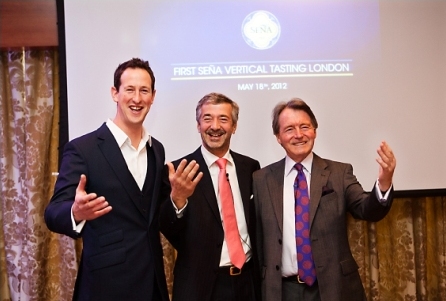 2 – Seña 1995 – Evolved hue, more so than 1. On the nose, it’s a bit soupy and odd, stewed somehow. Some cedar/sous bois, but it’s all a bit muddled. [Others noted a similar characteristic.] But the palate is better: lovely depth and resonance, warm spice, bay leaf complexity. Very fine savoury palate profile: elegant tannin, juicy fruit warmth, seems New World but very hard to call with this elegant age. Fluid, generous, nicely evolved. Maybe just lacking real core linearity on the finish. Very good though. An older Seña? I’d love to score it higher as other bottles may well be in better condition [cf the one I tasted in January 2012 in Chile] but on the evidence in hand: 7.5/10
2 – Seña 1995 – Evolved hue, more so than 1. On the nose, it’s a bit soupy and odd, stewed somehow. Some cedar/sous bois, but it’s all a bit muddled. [Others noted a similar characteristic.] But the palate is better: lovely depth and resonance, warm spice, bay leaf complexity. Very fine savoury palate profile: elegant tannin, juicy fruit warmth, seems New World but very hard to call with this elegant age. Fluid, generous, nicely evolved. Maybe just lacking real core linearity on the finish. Very good though. An older Seña? I’d love to score it higher as other bottles may well be in better condition [cf the one I tasted in January 2012 in Chile] but on the evidence in hand: 7.5/10
(Eduardo Chadwick commented: ‘This was the very first Seña vintage, made out of a selection of barrels – because the joint venture started officially in 1996. Blend of 70% Cabernet Sauvignon and 30% Carmenere – one of the largest proportions of Carmenere in any Seña. This was a pretty warm vintage in Chile.’)
3 – Seña 1997 – Pretty evolved hue, still quite deep/dense but almost seems older in its garnet and lack of purple than the previous two. Lovely scented nose, elegant and refined, still more to come. Palate is so savoury, so fine, this is top class wine. Dense, refined, super savoury: so cogent, lucid and fluid, it’s a joy and a triumph. A great vintage, showing wonderful maturity. Sensational wine: perfumed, drinkable, young, lithe, interrogative. Hard to fault. Still with plenty to go. My favourite wine of the tasting. 9.5/10
(Ronan Sayburn MS commented: ‘one of my top wines, I really enjoyed it: very fine and elegant. Seems European but then the ripe cassis points to very fine cool climate New World. A connoisseur’s wine.’
Eduardo Chadwick commented: ‘the 3rd vintage of Seña, this time the selection was made in the vineyard, working with Tim Mondavi to make a particular style, aiming for finesse and elegance. A very long season in coastal Aconcagua (this wine has around 20-30% of fruit from the Ocoa vineyard). When the MW party visited Chile in late 2011, this was the favourite from that tasting.’)
4 – Château Margaux 2001 – Notable evolution here. An entirely different register on the nose to what has gone before. It’s toasty. Perfumed. Floral. Smoky. Seems reminiscent of a Margaux style. Cool cedar notes, almost mint but not in a Chilean way. Very sleek, tangy attack, surely must be cool climate wine. Perhaps from a cooler vintage too. Fairly lean and without the stuffing to be from a top class vintage, but this is lovely elegant savoury claret. Streak of leafy pencil lead runs through it. Lovely resonance and length though. Not top drawer but very fine and very persistent. 8/10
(Steven Spurrier commented: ‘A fragrant, nicely Cabernet-dominant nose, with clarity and depth. Vigorous and firm, slightly raw. Perhaps needs time. Good luncheon wine.’ Charles Metcalfe commented: ‘My only quarrel was that the oak was a bit evident. Very precise blackcurrant fruit, good length, wine took over from the oak eventually. Needs time. Really liked it: just need to be patient!’)
5 – Seña 2001, 13.5% – Evolved hue. Quite an extrovert nose: warm earth, bay leaf and definitely some eucalypt so it seems immediately Chilean. Rich, broad, minty dark fruit, resinous character. Juicy mid-palate weight, speaks of sunny warmth – contrast with the previous wine! – also by contrast it lacks nobility. It’s a lovely evolved complex wine style, but a little bit lumpy and a bit too warming in alcohol. Nonetheless lovely savoury fine tannin, long, complex, true to type, and in the Chilean context very credible and creditable. 7.5/10
(Steven Spurrier commented: ‘Dark fruit, some Merlot sweetness, rich supple, some maturity, very nice balance, very good wine, not great.’ Patrick McGrath MW commented: ‘nice elegant fruit, one of my top wines.’
Eduardo Chadwick commented: ‘This wine came 2nd in the original Berlin tasting [in 2004]. The minty character is typical of our wines in cooler vintages, we struggled to get full ripeness. I personally like it when the wine is not overpowered by minty-ness, when it just adds nuance. Very little Carmenere here, just 4%, because of the cool vintage.’)
6 – Sassicaia 2005 – Pretty youthful colour in the context. Very young on the nose, really not giving much away. Then some slight mustiness/dirtiness edges in, hints of VA too. Either way it really doesn’t seem in great condition. In terms of its structure – tannin, acid – it seems Old World, but it also seems a little bit fault/rustic/dubious. Lots of finesse and concentration here but just not showing well today. My least favourite wine of the tasting as a result. 6.5/10
(General comment: this wine polarised the room. Many praised its energy, elegance and concentration – one sample comment was: ‘My top wine: terrific, a bit closed at the moment but seamless, very firm tannin, complete harmony, very impressive, just needs another 10 years.’ Others, like me (though probably in the minority), thought it somewhat out of condition and dubious… This split would have had an effect on the overall scoring.)
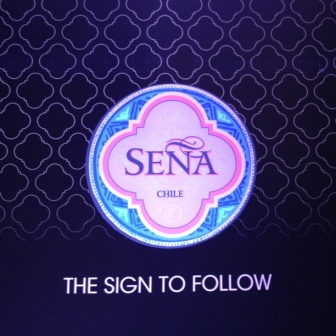 7 – Seña 2005, 14.5% – Pretty youthful hue but not super deep. Creamy, ripe, minty aromas – speaks of sunny Chilean climes. But not too overt in this context. Nicely put together and with a whiff of freshness as well as the sunny ripeness. Bay leaf and earth. On the palate it has lovely firm savoury tannin, very fine. Minty dark fruit but with freshness underlying. LOVELY harmony here, really love this. Young New World wine, yes warm and generous on the finish, but made impeccably and with real attention to detail, working for elegance. Very young and impressive. Love the tannin. Maybe just a bit hot on the finish, though, which brings it down a notch in the marks. If they managed that aspect, this would be a sensational wine. 8-7.5/10
7 – Seña 2005, 14.5% – Pretty youthful hue but not super deep. Creamy, ripe, minty aromas – speaks of sunny Chilean climes. But not too overt in this context. Nicely put together and with a whiff of freshness as well as the sunny ripeness. Bay leaf and earth. On the palate it has lovely firm savoury tannin, very fine. Minty dark fruit but with freshness underlying. LOVELY harmony here, really love this. Young New World wine, yes warm and generous on the finish, but made impeccably and with real attention to detail, working for elegance. Very young and impressive. Love the tannin. Maybe just a bit hot on the finish, though, which brings it down a notch in the marks. If they managed that aspect, this would be a sensational wine. 8-7.5/10
(Adam Lechmere commented: ‘Delicious, a really exotic flavour profile.’ Steven Spurrier commented: ‘Earthy, robust, good mid palate, tannins still there, just needs to evolve. Still young but everything in place.’)
Eduardo Chadwick commented: ‘A warm vintage in Chile. This was made from a selection of vineyards nearer the coast. For the first time we added Petit Verdot and Cabernet Franc. This has 57% Cabernet Sauvignon. A powerful expression of Seña. This had about 50% from the Seña estate itself, the rest from older vineyard blocks elsewhere in Aconcagua.)
8 – Tignanello 2008 – youthful, not super deep in colour. Restrained inky nose, reticent and young. Self-contained. Flows gently but firmly across the palate: very fine and savoury, sleek. Speaks of young classic Old World wine. Almost exponential tannic content, but so beautifully refined, silky, filigree. Speaks of a top quality wine in a top notch vintage which has been extracted diligently but not excessively. Either way this is a baby, and a prodigy at that. Has a bit of alcohol kick on finish but it’s well integrated. My second favourite of the tasting. 9/10
(Steven Spurrier commented: ‘I’m less enthusiastic about this wine as I have less time in front of me than Peter! Fine firm, good greenness on palate, still young, will soften, classy, have to wait.’)
9 – Seña 2008 – Very deep, very young in colour, with a very tight purple rim. Creamy, dense, inscrutable. Tons of ripe dark fruit and a touch of resin. Taste-wise, it’s a bit too hot and alcoholic, unfortunately. Lovely in almost every other respect. Maybe a bit too sweet-fruited and obvious as well. But lovely harmony of acid and plentiful fine tannin. Just needs to calm that heat a bit. Seems like a very young Seña: impressive but too hot. 7.5-7/10
[General note: when this wine was revealed, it generated a round of applause! This was the overall group favourite of the tasting, albeit my second to last. Christine Parkinson commented: ‘A top wine: lovely balance, harmony, super ripe fruit, lots of finesse, complexity and length. It held together beautifully.’ Steven Spurrier commented: ‘lots of ripenes and elegance, hard not to be seduced by this wine.’ Greg Sherwood MW commented, ‘My 2nd wine, it takes fine Chilean wine up that extra step – a tiny bit of warmth, which goes with the territory, but wonderful minerality and oak and fruit, great balance, very impressive: very Chilean, but goes the extra yard.’
Eduardo Chadwick commented: ‘The current release: 57% Cabernet Sauvignon, 20% Carmenere, 10% Merlot, 5% Cab Franc, some Petit Verdot. The Seña vineyard was coming in to age, having been planted in 1999, and contributing some varieties we didn’t have in the past. This wine was sourced roughly 80% from the Seña estate, plus older vineyards from Aconcagua. A cool vintage with good acidity. In the Hong Kong Seña vertical in 2011, this was top of the tasting.’]
10 – Seña 2010 – Very deep, dark, dense hue with a tight purple rim. Super creamy aromas with a slightly reductive edge. Very, very young and lots of baby fat here; difficult to discern beyond this its origin etc. Tannin is very fine, acidity crisp; this is a fab wine wherever it came from. A conundrum really! It has the tannin and texture and acidity of the Old World but there’s a real generosity and warmth on the finish too. So either a very ripe Old World vintage or a brilliantly crafted New World red. I’m afraid the alcohol really does bring it out of the top flight for me, though. If it didn’t have that it would be sensational wine. 8-7.5/10
[General note: another wine which, when revealed, was honoured with a round of applause. Steven Spurrier commented: ‘Very young and vigorous; fine mid-palate, lots of potential, needs to gain complexity. Would have judged it higher tasting it now than half an hour ago. At the moment the sweetness dominates but it’s actually absolutely stunning.’
Eduardo Chadwick commented: ‘This is an ‘en primeur’ sample! Bottled in March, not yet released. It’s to give an idea of the wine that’s coming – it hasn’t yet integrated. A cool vintage. This will be a classic, elegant, pure style. I’m very fond of it and think it will evolve very well. Around 50% Cabernet Sauvignon and 15% Carmenere then bits of everything (but not syrah).]

